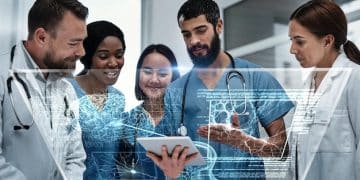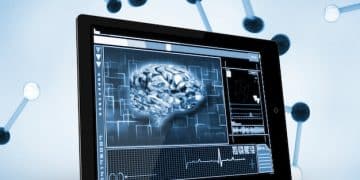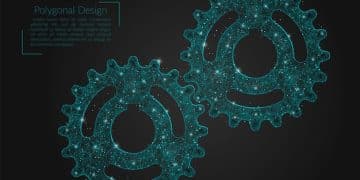Tech’s Impact: Improving US Healthcare Outcomes
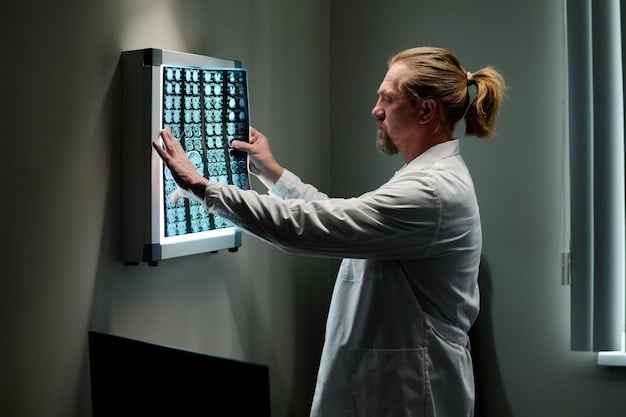
Technology’s transformative role in enhancing healthcare outcomes across the US is manifest through innovations like AI-driven diagnostics, telemedicine expansion, and personalized medicine, collectively reshaping patient care and operational efficiencies.
In an era defined by rapid technological advancement, the question of how is technology being used to improve healthcare outcomes in the US has become increasingly central. From AI to telemedicine, a silent revolution is underway, reshaping how medical care is delivered and experienced.
The digital transformation of diagnostics and imaging
The landscape of medical diagnostics and imaging in the US is undergoing a profound transformation, driven by an influx of cutting-edge technologies. These innovations are not merely enhancing efficiency but fundamentally improving the accuracy and speed of diagnoses, leading to better patient outcomes.
One of the most significant strides involves artificial intelligence (AI) and machine learning (ML) applications in radiology and pathology. AI algorithms can analyze vast datasets of medical images, such as X-rays, MRIs, and CT scans, with a precision that often surpasses human capabilities. This enhanced analytical power translates into earlier detection of diseases like cancer, cardiovascular conditions, and neurological disorders.
AI in imaging analysis
The integration of AI in diagnostic imaging is multifaceted, focusing on pattern recognition and anomaly detection. These systems learn from millions of previously analyzed images, identifying subtle indicators that might escape the human eye. The goal is not to replace radiologists but to augment their abilities, reducing burnout and improving diagnostic consistency.
- Enhanced detection of subtle abnormalities
- Reduced false-positive rates, minimizing unnecessary follow-ups
- Faster processing of large volumes of images
- Improved diagnostic accuracy in complex cases
Beyond traditional imaging, AI is also being deployed in digital pathology, where it assists in the analysis of tissue samples. By recognizing microscopic anomalies indicative of disease, AI tools help pathologists categorize and diagnose conditions more efficiently and accurately. This is particularly crucial for cancer diagnosis and grading, directly impacting treatment planning.
Another area seeing considerable technological advancement is molecular diagnostics. Techniques like next-generation sequencing (NGS) allow for a detailed analysis of an individual’s genetic makeup, identifying predispositions to diseases or specific genetic mutations that might influence drug efficacy. This personalized approach is a cornerstone of precision medicine.
In summary, the digital transformation of diagnostics and imaging is not just about faster results; it’s about fundamentally altering the diagnostic pathway, making it more accurate, precise, and ultimately, more patient-centric. These advancements pave the way for earlier interventions and more tailored treatment strategies, significantly improving healthcare outcomes.
Telemedicine and remote patient monitoring: extending care beyond walls
Telemedicine and remote patient monitoring (RPM) have emerged as pivotal technologies in extending healthcare access and improving outcomes, particularly in a vast and diverse country like the US. These digital health solutions bridge geographical gaps, alleviate burdens on traditional healthcare facilities, and empower patients to manage their health more effectively from the comfort of their homes.
The adoption of telemedicine escalated dramatically during recent global health crises, demonstrating its immense potential. It encompasses a wide range of services, from virtual consultations with primary care physicians and specialists to online therapy sessions and medication management. This accessibility is especially vital for individuals in rural areas or those with mobility issues, ensuring timely medical advice and intervention.
Virtual consultations and improved access
Virtual consultations reduce the need for in-person visits, saving patients time and travel costs. For providers, it optimizes scheduling and can reduce the administrative overhead associated with traditional appointments. This model supports continuous care, allowing for more frequent check-ins and better management of chronic conditions.
- Increased accessibility for rural and underserved populations
- Reduced waiting times for appointments
- Convenience for patients with chronic conditions or disabilities
- Lower associated costs for patients (travel, time off work)
Remote patient monitoring takes this a step further by utilizing wearable devices and home-based sensors to collect crucial health data in real-time. This can include vital signs like blood pressure, heart rate, oxygen levels, and glucose readings. The data is then transmitted securely to healthcare providers, who can monitor trends, predict potential issues, and intervene proactively.
RPM is particularly beneficial for managing chronic diseases such as diabetes, hypertension, and congestive heart failure. By continuously monitoring key metrics, providers can adjust treatment plans as needed, prevent acute exacerbations, and reduce hospital readmissions. This proactive approach not only improves quality of life for patients but also contributes to significant cost savings within the healthcare system.
The integration of AI with RPM data is also beginning to show immense promise, allowing for predictive analytics that can alert providers to deteriorating conditions before they become critical. This foresight enables timely interventions, preventing serious health crises and improving long-term outcomes.
Ultimately, telemedicine and remote patient monitoring are not just supplementary services; they are becoming integral components of the healthcare delivery model in the US. By leveraging technology, they extend the reach of care, empower patients, and pave the way for a more efficient, accessible, and responsive healthcare system, directly contributing to improved outcomes for millions.
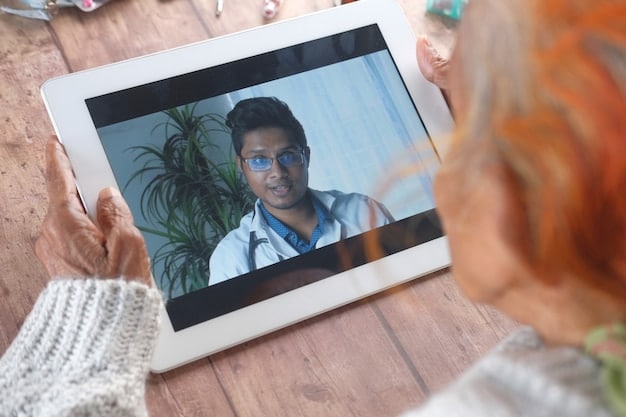
Personalized medicine: tailoring treatment with genetic insights
Personalized medicine, often referred to as precision medicine, represents a paradigm shift in healthcare, moving away from a “one-size-fits-all” approach to one that tailors medical treatment to each individual’s unique characteristics. This revolution is heavily dependent on advanced technological capabilities, particularly in genomics and bioinformatics.
At its core, personalized medicine leverages information about an individual’s genes, proteins, environment, and lifestyle to prevent, diagnose, and treat disease more effectively. The most prominent application involves pharmacogenomics, which studies how genes affect a person’s response to drugs. By understanding an individual’s genetic makeup, doctors can predict whether a particular medication will be effective or if it might cause adverse reactions, thus optimizing drug therapy.
Genomic sequencing and drug efficacy
Next-generation sequencing (NGS) technologies have made genomic sequencing faster and more affordable, allowing for routine analysis of an individual’s genome. This data provides invaluable insights into genetic predispositions to diseases, as well as how different individuals metabolize various medications.
- Optimizing drug dosages based on genetic profiles
- Minimizing adverse drug reactions
- Identifying the most effective treatments for specific cancers
- Preventing diseases through early genetic risk assessment
In oncology, personalized medicine is already transforming cancer care. Genetic sequencing of a tumor can reveal specific mutations that drive its growth, allowing oncologists to select targeted therapies designed to attack those precise genetic alterations. This approach, known as companion diagnostics, often leads to better responses and fewer side effects compared to traditional chemotherapy.
Beyond drug selection, personalized medicine is also influencing disease prevention. By identifying individuals with a higher genetic risk for certain conditions, preventative strategies can be implemented much earlier. This might include lifestyle modifications, regular screenings, or prophylactic measures, significantly improving long-term health outcomes.
The data generated by genomic sequencing and other ‘omics’ technologies (proteomics, metabolomics) is immense. Bioinformatics tools and computational power are essential to analyze this complex data, identify meaningful patterns, and translate them into actionable clinical insights. This interdisciplinary approach is what makes personalized medicine feasible and effective.
While still evolving, personalized medicine holds the promise of making healthcare more predictive, preventive, personalized, and participatory (P4 medicine). By harnessing the power of an individual’s unique biological blueprint, technology is enabling a future where medical treatments are truly tailored, leading to superior health outcomes across the US healthcare system.
Wearable tech and sensor devices: empowering proactive health management
The proliferation of wearable technology and advanced sensor devices is fundamentally changing how individuals monitor and manage their health, shifting the paradigm from reactive sickness care to proactive wellness management. These innovations are placing powerful health insights directly into the hands of consumers and healthcare providers, fostering a more engaging and effective approach to personal health.
Wearable devices, ranging from smartwatches and fitness trackers to specialized medical sensors, continuously collect a wealth of physiological data. This includes heart rate, sleep patterns, activity levels, skin temperature, and even ECG readings. While many of these devices are designed for general wellness, an increasing number are receiving regulatory clearance for medical applications, such as detecting atrial fibrillation or monitoring glucose levels.
Continuous data collection for early intervention
The ability of these devices to collect data continuously, outside of clinical settings, provides an unprecedented longitudinal view of an individual’s health. This persistent monitoring can identify subtle changes or emerging patterns that might indicate a health issue before severe symptoms appear, facilitating early intervention.
- Real-time tracking of vital signs and activity
- Early detection of cardiac anomalies or sleep disorders
- Motivation for healthier lifestyle choices
- Integration with healthcare platforms for data sharing
Beyond simple fitness tracking, advanced sensor devices are making significant inroads in specific medical applications. For instance, continuous glucose monitors (CGMs) have revolutionized diabetes management, providing real-time glucose readings that enable patients to make informed dietary and activity decisions, significantly improving glycemic control and reducing the risk of complications.
Similarly, smart patch sensors are being developed for monitoring everything from medication adherence to wound healing. These unobtrusive devices collect data passively, reducing the burden on patients and providing clinicians with objective measures of treatment efficacy or recovery progress.
The data generated by these wearables and sensors is often integrated with smartphone apps or cloud-based platforms, allowing both users and, with consent, their healthcare providers to access and analyze the information. This creates a feedback loop that empowers individuals to take a more active role in their health management and enables clinicians to offer more personalized and timely advice.
As these technologies become more sophisticated and accurate, their role in improving healthcare outcomes in the US will only expand. By providing continuous, actionable insights into personal health, wearable tech and sensor devices are fostering a culture of proactive health management, leading to healthier lives and more efficient healthcare delivery.
Artificial intelligence and machine learning in drug discovery and development
The arduous and costly process of drug discovery and development is undergoing a dramatic transformation with the integration of artificial intelligence (AI) and machine learning (ML). These computational powerhouses are accelerating every stage of the drug pipeline, from identifying novel drug targets to predicting clinical trial outcomes, ultimately leading to faster and more effective treatments for patients.
Traditionally, drug discovery is a long, expensive, and high-risk endeavor, often taking over a decade and billions of dollars with a very low success rate. AI and ML algorithms can sift through vast amounts of biological, chemical, and clinical data at speeds unimaginable to humans, identifying patterns and relationships that would otherwise remain hidden.
Accelerating drug pipelines
One of the primary ways AI accelerates drug discovery is by streamlining target identification and validation. AI models can analyze genomic, proteomic, and disease-related data to pinpoint specific molecules or pathways that, when modulated, could effectively treat a disease. This reduces the time and resources spent on less promising targets.
- Faster identification of potential drug candidates
- Optimized synthesis of new molecular entities
- More accurate prediction of compound efficacy and toxicity
- Reduced cost and time in preclinical stages
Beyond target identification, AI is also revolutionizing lead optimization. ML algorithms can predict how slight modifications to a chemical compound will affect its binding affinity, stability, and absorption, distribution, metabolism, and excretion (ADME) properties. This allows researchers to rapidly design and test improved drug candidates computationally, minimizing the need for extensive laboratory synthesis and testing.
In preclinical development, AI can model the potential toxicity of compounds and predict their interactions with various biological systems. This “in silico” testing reduces the reliance on animal testing and helps identify potential issues much earlier, preventing costly failures in later stages of development.
Even clinical trials are benefiting from AI. ML can optimize patient recruitment by identifying ideal candidates for specific trials, analyze vast amounts of clinical trial data to spot trends and side effects, and even predict the probability of a drug’s success. This data-driven approach can make trials more efficient, shorter, and ultimately, more successful.
The promise of AI in drug discovery is immense. By democratizing and accelerating the development process, AI and ML are poised to bring urgently needed new treatments to market faster, more cheaply, and with a higher probability of success, directly improving healthcare outcomes for patients across the US and globally.
Robotics and automation: enhancing precision and efficiency in surgery and pharmacy
Robotics and automation are no longer confined to manufacturing plants; they are increasingly playing a critical role in healthcare, particularly in improving precision, efficiency, and safety in surgical procedures and pharmaceutical operations. These technological advancements are leading to superior patient outcomes by reducing human error, enhancing accuracy, and streamlining complex processes.
In the operating room, robotic-assisted surgery has become a game-changer. Systems like the da Vinci Surgical System allow surgeons to perform complex procedures with enhanced dexterity, precision, and control. The robot’s “arms” can articulate beyond the range of human hands, and its 3D high-definition vision system provides a magnified view of the surgical site, enabling minimally invasive operations with greater accuracy.
Benefits in surgical precision
Minimally invasive robotic surgery typically results in smaller incisions, which translates to several benefits for the patient: reduced pain, less blood loss, lower risk of infection, shorter hospital stays, and faster recovery times. This leads to significantly improved post-operative outcomes and a quicker return to normal life.
- Increased surgical precision and control
- Reduced invasiveness, leading to quicker recovery
- Lower risk of complications and infections
- Enhanced surgeon capabilities for complex procedures
Beyond the operating room, robotics are also transforming pharmacy operations. Automated dispensing systems, for example, accurately and efficiently prepare and dispense medications, reducing the chance of human error in medication counting and labeling. This automation is crucial for patient safety, ensuring that the right patient receives the right medication at the right dosage.
Furthermore, robotic systems are being used in compounding pharmacies to precisely mix custom medications, particularly for sterile preparations. This highly precise automation helps maintain sterility and ensures accurate drug concentrations, which is critical for patient adherence and therapeutic effectiveness.
The integration of automation extends to hospital logistics, where autonomous mobile robots (AMRs) transport supplies, medications, and laboratory samples. This frees up hospital staff to focus on patient care, improves logistical efficiency, and contributes to a more organized and responsive healthcare environment.
In essence, robotics and automation are driving a significant improvement in clinical precision and operational efficiency within US healthcare. By taking on tasks requiring high levels of accuracy and repetitive motion, these technologies enhance the safety and effectiveness of various medical procedures and processes, directly leading to better healthcare outcomes for patients.
Data analytics and interoperability: building a connected healthcare ecosystem
The sheer volume of health data generated daily in the US healthcare system is staggering, encompassing everything from electronic health records (EHRs) and diagnostic results to claims data and wearable device metrics. Harnessing this “big data” through advanced analytics and ensuring seamless interoperability among disparate systems are critical for improving healthcare outcomes.
Data analytics in healthcare involves processing and interpreting this vast information to identify trends, predict patient risks, optimize treatment plans, and enhance operational efficiency. It’s about moving from raw data to actionable insights that inform clinical decisions and administrative strategies.
Unlocking insights from health data
One of the most immediate benefits of robust data analytics is in population health management. By analyzing aggregated patient data, healthcare organizations can identify at-risk populations, pinpoint areas with unmet medical needs, and design targeted interventions to improve community health outcomes. This proactive approach can reduce disease incidence and manage chronic conditions more effectively.
- Identifying at-risk and underserved populations
- Predicting disease outbreaks and health trends
- Optimizing resource allocation and operational efficiency
- Enhancing clinical decision support for providers
Interoperability, the ability of different information technology systems and software applications to communicate, exchange data, and use the information that has been exchanged, is the backbone of effective data analytics in healthcare. Without seamless data flow, valuable insights remain siloed, hindering comprehensive patient care.
Efforts to improve interoperability have focused on standardized data formats (e.g., FHIR – Fast Healthcare Interoperability Resources) and secure data exchange networks. When patient information can flow freely and securely between primary care physicians, specialists, hospitals, and pharmacies, it creates a complete and accurate picture of a patient’s health journey. This integrated view minimizes medical errors, reduces redundant tests, and ensures continuity of care.
For clinicians, robust data analytics tools, often embedded within EHR systems, provide enhanced clinical decision support. They can alert providers to potential drug interactions, suggest evidence-based treatment protocols, or highlight patients due for preventative screenings. This real-time access to intelligent insights empowers more informed and effective clinical decisions.
Ultimately, a truly connected healthcare ecosystem, powered by advanced data analytics and seamless interoperability, is essential for a future where patient care is not only reactive butalso predictive and personalized. By transforming raw data into meaningful intelligence, these technologies are pivotal in improving healthcare outcomes across the US.

| Key Tech Advancement | Impact on Healthcare Outcomes |
|---|---|
| 🔬 AI Diagnostics | Enhances accuracy & speed of disease detection, leading to earlier intervention. |
| telehealth | Expands healthcare access, reducing barriers for patients, especially in rural areas. |
| 🧬 Personalized Medicine | Customizes treatments based on individual genetics, improving efficacy and safety. |
| 🤖 Robotics | Boosts surgical precision and pharmacy efficiency, leading to better patient safety. |
Frequently asked questions
▼
AI algorithms analyze vast quantities of medical images and data, identifying subtle patterns and anomalies that human eyes might miss. This leads to earlier and more precise detection of diseases like cancer, improving the chances of successful treatment and better patient outcomes by facilitating timely interventions.
▼
Telemedicine significantly increases access to healthcare, especially for individuals in rural areas or with limited mobility. It reduces travel time and costs, provides convenience for routine check-ups, and enables continuous management of chronic conditions, ultimately breaking down traditional barriers to receiving timely medical care.
▼
Personalized medicine uses genomic sequencing and bioinformatics to tailor treatments to an individual’s unique genetic makeup. This ensures that patients receive the most effective medications at optimal dosages, minimizes adverse drug reactions, and allows for targeted therapies, particularly evident in advanced cancer treatments.
▼
Wearable technologies and sensor devices continuously collect health data like heart rate, sleep patterns, and activity levels. This real-time monitoring allows individuals and their healthcare providers to identify potential health issues early, encouraging proactive lifestyle changes and enabling timely clinical interventions before conditions become severe.
▼
Automation in hospital pharmacies, through robotic dispensing and compounding systems, dramatically reduces human error in medication preparation and delivery. This precision ensures patients receive accurate dosages of the correct medications, thereby enhancing patient safety, streamlining pharmacy operations, and preventing potentially harmful drug-related incidents.
Conclusion
The journey of healthcare in the US is undeniably intertwined with technological evolution. From the intricate precision of AI-driven diagnostics and personalized genomic treatments to the expansive reach of telemedicine and the efficiency of robotic surgery, technology is not just augmenting, but fundamentally redefining, the parameters of patient care. These innovations are paving the way for a healthcare system that is more accessible, precise, preventive, and ultimately, more effective in delivering improved outcomes for every individual. As we look towards the future, the continuous integration of cutting-edge technology promises an even healthier landscape for all.
